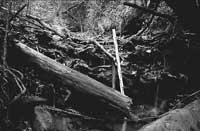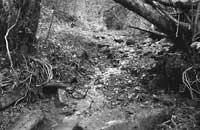Wooden deposits in rivers
In other regions, especially in the western United States, it has been observed that dead trees falling into the river often form wooden dams that are of great importance in river communities. On the one hand, they stabilize the channel, accumulate fine sediments and offer new habitats to living beings. In addition, they retain the litter that reaches the river, which being the main forage of the river's invertebrates, produces a greater number of invertebrates in streams with abundant wooden dams and a greater production of fish.

Finally, the wells and inert waters that are generated in the vicinity of wooden dams are the main refuge for living beings to cope with flooding and, consequently, by eliminating wooden dams, floods cause a greater impact on river communities.
Despite the importance of wood, many human actions (especially logging and logging) have contributed to fewer and fewer logs in our rivers, affecting their diversity and function. Most of the studies on this area have been carried out in North America and New Zealand, although the degree of impoverishment of European rivers by the elimination of wood is unknown. This is the first research carried out in Southern Europe.
This project has two main objectives: on the one hand, to know the presence of logs in the rivers of the Basque Country, and on the other hand, the impact of the topography of the channel and of the forest management on it. On the other hand, observe the importance of wood in the morphological diversity of rivers, in the abundance of habitats, in the communities of invertebrates and in their capacity to cope with the floods. The study is being carried out on the Aguera River, which is the best preserved of the Biscayan rivers.
As has been observed, the river sections that are under pine trees, eucalyptus and young alisedas have a lower presence of wood than those that are under adult oak trees and the influence of logs is less.
To analyze the influence of wood, all the wood existing in two streams has been removed and its influence on the riverbed substratum, the capacity of the river to retain the orbela, the abundance of microhabitats and the ability of invertebrates to cope with flooding is being observed.

Woodless rivers have lost much more sediments than control groups, reduced habitat diversity and modified invertebrate communities. It remains to be seen whether floods affect woodless rivers more.
The results of this project will allow us to better understand the impact of forest exploitation on river communities and find ways to reduce it. If we want to improve the quality of the Basque rivers, we cannot settle for improving the quality of the water. In addition, the state of the physical habitat of living beings and their hydrological functioning should be observed. This type of research can help a lot to know the state and natural functioning of our rivers and, therefore, to restore the affected rivers.
- Project title: Dynamics
and function of wood accumulators: relationship with arrokolandaredia. - Objective: Verification of the presence of logs in the rivers of the Basque Country and study of riverbed topography and forest
management. - Financing: DCICYT, UPV.
- Director: Jesús Pozo.
- Research team: Director:
Jesús Pozo, Professor of Ecology.
Ana Basaguren and Arturo Elosegi.Doctor
Scholar: Bosco Imbert.Doctoral
fellows: Jon Molinero,
Jose Manuel González and Joserra Diez. - Department: Department of Plant Biology
and Ecology. - Centre: Faculty of Sciences of Leioa.





